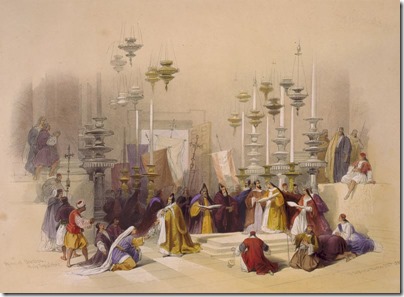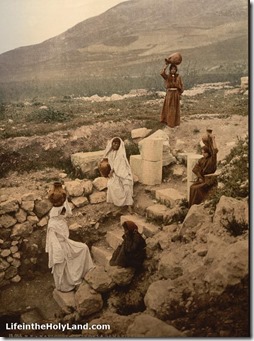The winners for this survey were the city of Jerusalem (7 different churches proposed), with the Church of the Holy Sepulcher receiving the most individual votes. Bethlehem has two favorite churches, and Galilee two others. Only two churches were selected outside of the land of Israel. Here is a brief review of a few of the favorites and some reasons they were chosen.
The Church of the Holy Sepulcher in Jerusalem
“Each time, I always find something new and interesting to learn about the history of this church.
And it seems likely that some of history’s most significant events happened within its walls.”
“There is just something about this place for me. To think it may have been the site of Jesus’ crucifixion, burial and resurrection for one gives me goose bumps. Then there is the building’s long history and its levels and twists and turns. It’s also interesting to watch the people.”
Lithograph by David Roberts
The Church of All Nations (Gethsemane)
“Wonderful mosaic of Jesus, the natural light inside, the location, the symbolism of the name.”
Christ Church (Jerusalem)
“Ministry to Jews – no statues – clean architecture.”
Church of St. Anne (Jerusalem)
“The beautiful acoustical sound as songs of worship are sung by peoples of all languages – creating
for me an atmosphere of praise to the Lord!”
Dominus Flevit (Jerusalem)
“The location and view from the church toward the Old City, emphasizing Temple grounds and beyond the Holy Sepulchre.”
Church of the Nativity (Bethlehem)
“Stubbornly commemorates the birthplace of Messiah in the city of the birthplace of David.”
Church of the Shepherds’ Field (Bethlehem)
“Singing Christmas carols (I sang O Holy Night here) with the beautiful acoustical sound
reverberating throughout reminding us of Christ’s birth somewhere near here.”
Emmaus-Nicopolis
“Beautiful and full of peace.”
Church of the Primacy (Tabgha)
“It is small and intimate…but mostly for the setting right along the Sea of Galilee.”
Duc In Altum (Magdala)
“Because it is beautiful, particularly the mural depicting the woman with the discharge of blood.”
Sardis (Turkey)
“On the southeast corner of the magnificent ruins of the Temple of Artemis at Sardis is a small brick church built around the 4th century CE after the Temple had fallen into disuse. It’s one of the earliest church structures in existence. I like it because, although it pales in compares to the Temple of Artemis, it is a testimony to the power of God in the presence of things the world considers to be of no consequence. I appreciate being able to reflect in a relatively quiet spot where Christians gathered 1400 years or so ago.”
Titus Church (Crete)
“Went to church there one Sunday morning while my wife went to Knossos. Really good experience.”
Thanks to all who participated. August is over, but we’ve enjoyed this enough to continue it in the coming months, though probably less frequently than once a week.










